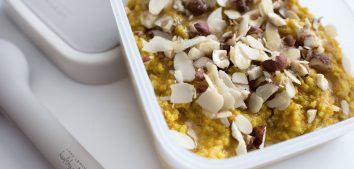
Probiotics: How to Choose Them? – Products Worth Using in Seasonal Infections
It is true that on the plane we should first put on our oxygen mask and only then help our child, but … we know perfectly well that for every parent their child is the greatest treasure! 🙂 That’s why the first post on how to choose a good probiotic concerned our little ones. Now, when our children are already “probiotic secured”, we can focus on slightly older children, that is adults 🙂
Stress
Once again, we emphasize that building immunity is largely a matter of implementing proper eating habits and hygiene of life every day. While a significant role in children is primarily played by a healthy, balanced diet and physical activity (including the right amount of movement in the open air), in adults there are additional factors that need to be taken care of. We are talking about avoiding stimulants, minimizing everyday stress (if possible!), and ensuring adequate amount of sleep per day. We should remember that the basis of a well-functioning immune system is primarily to “free” it from unnecessary burden (such as excessive stress), so that it can carry out its mission without hindrance.
Gut bacteria
We assume that you already know the role of intestinal microbiota in the proper functioning of our immune system. After all, this is not the first post on this subject 🙂 Bacteria which inhabit digestive tract from the first days of our life play the role of “instructors” of the GALT immune system located in the intestine. And they have a lot to do! About 70% of immune cells are located in the digestive tract. So if we want to improve the functioning of our immunity, we must clean the intestine!
Multistrain probiotics
We begin our list of recommended products with multi-strain probiotics containing more than 1 probiotic strain. You may not find information on the packaging of these preparations that they affect immunity and using them will prevent you from falling ill so often. They are supposed to have a completely different role. We use multi-strain probiotics to provide comprehensive support for the intestinal ecosystem. Specially selected strains contained in these supplements temporarily attach to the intestinal epithelium (adhesion) to begin a number of activities that support the disturbed microbiome. We are talking about their antagonistic influence on potentially pathogenic bacteria or yeast-like fungi, which can multiply in the gastrointestinal tract under the influence of such factors as antibiotic therapy, past diseases, unhealthy diet or excess stress. With the simultaneous reduction of our bacterial friends of the genus Lactobacillus or Bifidobacterium, intestinal dysbiosis occurs. The first symptoms are usually deterioration of the digestive tract, diarrhea, flatulence, stomach ache. However, if this condition lasts longer, it may additionally “deregulate” the work of the immune system. For efficient functioning, our immunity needs constant stimulation and activation on the part of intestinal bacteria. In practice, this means that people with impaired microbiota have weaker immunity, they can catch infections more often, and the course of the disease can be more severe. these are not only respiratory infections, but also infections of the digestive tract or intimate ones.
That’s why we recommend high-quality multi-strain probiotics as a first step to stimulate the GALT immune system. Stimulating immune structures is the task of our own microbiota, probiotics are here just to help in its reconstruction. In part, probiotic strains also exert a direct immunostimulatory effect by stimulating the immune system to increase the production of antibodies and cytokines.
The amount of bacteria matters!
All the probiotics we’ve chosen to describe are characterized by a high concentration of healthy bacteria. Remember that this is a necessary requirement for the probiotic to work at all! The vast majority of strains will be digested in the upper gastrointestinal tract (stomach, duodenum), and yet the target site of the probiotic’s activity is the large intestine, which is a kind of “kingdom”! This is where most of the intestinal microbiome is located. For this reason, a good-quality probiotic contains a high concentration of bacteria so that the right amount reaches the target site. If the number of probiotic bacteria in the preparation is too low, it may be the reason for its ineffectiveness.
VSL#3
Multi-strain preparations worth recommending certainly include the probiotic mix VSL # 3, based on 8 selected probiotic strains of the genera Lactobacillus, Bifidobacterium and Streptococcus. The content of live probiotic bacteria in this product is up to 450 billion, and in terms of numbers, hardly any preparation can match it. In addition, it is one of the best-tested probiotic preparations in the world, with proven effectiveness and one of the best preparations of this type available on the Polish market. The main purpose of VSL # 3 is to support traditional pharmacological treatment in patients with inflammatory bowel disease (Crohn’s disease, ulcerative colitis), as it contributes to alleviating inflammation in the gastrointestinal tract and maintaining the disease’s remission (silencing the disease process). The use of the preparation is also recommended for patients with irritable bowel syndrome, as it contributes to the relief of symptoms.
One of the leading properties of this polyprobiotic is the ability to strongly inhibit inflammation and intensively support the reconstruction of normal microbiota. For this reason, we can definitely recommend it as a product that positively affects the intestinal ecosystem, which is reflected in the improvement of immunity. If any probiotic can be called a “medicine for microflora” it is definitely VSL # 3.
Lactichoc
Another multi-strain preparation which is worth recommending is Lactichoc, which contains 40 billion probiotic bacteria in 1 capsule, represented by Bifidobacterium lactis LA304, Bifidobacterium bifidum LA803, Bifidobacterium lactis LA804, Bifidobacterium breve LA805, Lactobacillus acidophusus acidophilus LA807. These bacteria come from the internationally recognized Pasteur Institute in France. Due to the high concentration of bacteria in the preparation and the unique strain composition, this probiotic is even considered as an alternative to microflora transplantation – a life and health saving procedure for many patients with pseudomembranous colitis. So you can try to imagine how powerful it is! The recommended time of supplementation aimed at the reconstruction of the microbiota is 10 days which means it’s quick and intense 🙂 It can be used in any situation where intestinal ecosystem disorders occur, including inflammatory bowel disease or long-term antibiotic therapy, but also – when we simply want to rebuild your microbiome in a comprehensive way to improve immunity during the flu season.
N1 Probiotic Lab One
We also recommend the product N1 Probiotic Lab One. As the name suggests, it is at the forefront of the highest quality probiotic products, and more specifically – synbiotic, because the acacia fiber it contains acts as a “fuel” for the bacteria here. It has 10 different probiotic strains, in a high concentration of 30 billion strains per capsule (Bifidobacterium breve BR03 Bifidobacterium lactis BS01, Lactobacillus paracasei LPC00, Lactobacillus rhamnosus LR06, Lactobacillus plantarum LP09, Lactobacillus casei 02 YO8, Bifidobacterium longum BL03). The bacteria present in the capsule reach practically the same amount in the colon due to the innovative microencapsulation method, which increases the effectiveness of this preparation. You can successfully use it to restore intestinal microbiota and for subsequent regulation of the immune system. Supplementation is also recommended in any situation in which intestinal ecosystem disorders may occur, such as antibiotic therapy or physical activity at a high level of performance.
Mycobiotic (Nature Science) and Biotic Pro
Our next proposal is a Polish probiotic (!), which is gaining more and more popularity. I am talking about Mycobiotic (Nature Science). It contains 3 innovative, patented strains of bacteria of Polish origin (Bifidobacterium animalis AMT 30, Lactobacillus Plantarum AMT 14 and Lactobacillus Plantarum AMT 4), in a concentration of 17 billion per serving. Strains of these bacteria show extremely high antagonistic activity against Candida yeast (therefore they are especially recommended for patients with recurrent fungal infections). The bacteria contained in the product can also successfully fight such pathogens as Salmonella, Staphylococcus (staph) or pathogenic Escherichia coli strains. The elimination of unwanted microbes is essential for rebuilding the correct microbiota, hence our appreciation for the product.
Thanks to these properties, the described probiotic received a positive opinion of the Polish Academy of Sciences, and we couldn’t agree more 🙂 Another product from the family is Biotic Pro, based on the strains Lactobacillus plantarum AMT14 and Bifidobacterium animalis AMT30. BioticPro is a synbiotic because in addition to the content of probiotic strains it also contains mannitol and inulin (food for beneficial bacteria), which additionally supports the intestinal microbiome. In our opinion, it’s better to use Mycobiotic when there is damage to the microbiome (e.g. as a result of antibiotic therapy), when we suffer from gastrointestinal complaints or we have a serious problem with recurrent infections, or, in short, symptoms of intestinal dysbiosis. However, if we want to act rather preventively (which we highly approve!) and simply support the bacteria in our intestines every day, Biotic Pro will be a better solution. One of the products can therefore be treated as regeneration of damaged microflora, while the other as a prophylactic option.
The above preparations comprehensively support the intestinal microbiome so that it’s ready for training our intestinal immunity. In our opinion, a good multi-strain probiotic is the basis for comprehensive reconstruction of the intestinal microbiota.
Lactibiane Immuno
It is time to introduce other members of the probiotic family, focused on improving immunity. Lactibiane Immuno certainly leads the way in this group. The main purpose of this preparation is to affect the immune system, and the strains Lactobacillus paracasei LA 802, Lactobacillus acidophilus LA 201 contained in it have strong immunomodulatory properties. This action is enhanced by the addition of vitamins C and D3. The probiotic strains present here also support the functioning of the intestinal barrier, which is an important protective element inside our body. This preparation is a great supplement to the reconstruction of the microbiota with the use of multistrain probiotics, it can also be used on its own. You can use it both as a prophylaxis during periods of increased susceptibility to infection and to support immunity in people with the problem of recurrent infections. And in both cases it works fine. Interestingly, this is not a supplement only for people who catch a cold every now and then! Lactibiane Immuno also prevents oral infections, and this is a problem for a significant part of our society. The preparation can also be successfully used by children over 6 years of age.
Single-strain probiotics
Entero Acidolac and Acidolac
I would also like to mention here two single-strain preparations, which were discussed in detail in the previous post about probiotics for children. I am talking about the LGG strain and non-pathogenic yeast Saccharomyces boulardii. These microorganisms activate the immune system in the positive way, even by stimulating the production of antibodies. So these probiotics are not so much focused on comprehensive reconstruction of the microbiome as on effective stimulation of the GALT immune system. The strains described can be found, among others, in Entero Acidolac (Saccharomyces boulardii) and Acidolac drops (LGG).
Lab One N1 Colostrum
Similarly to children who are often ill, probiotic supplementation in adults with recurrent infections should be enhanced by additional immunostimulants. Some of you may have heard about colostrum. There are many colostrum preparations on the market and it is often difficult to decide which ones to choose. Due to the quality of the raw material, we recommend Lab One N1 Colostrum, which contains 400 mg of pure colostrum in one dose. Bovine colostrum is obtained up to 4 hours after delivery, immediately after the start of lactation, which guarantees high activity of the preparation. What will you find in colostrum and why is it such an immunity booster? Well, there are a number of compounds here with antiviral, antibacterial, and anti-fungal activity (lactoferrin, lysozyme, antibodies), also hormones, enzymes, derivatives of amino acids or nucleic acids: what your heart desires 🙂 This great wealth of biologically active compounds in colostrum results from the fact that the mother’s body immediately after giving birth tries to provide the baby with the best protection against germs from the outside world. And this applies to all mammals 🙂 Because of this, naturally fed newborns and infants are usually more resistant to infection than their peers receiving modified milk. Fortunately, even in adulthood, we can enjoy this benefit of nature using bovine colostrum, which also has a positive effect on the regeneration of the intestinal barrier.
We hope that our practical guide to probiotic preparations has been helpful for you and now you know what kind of probiotics you can try if you want to strengthen the immune system from the gut side.
Good advice
Once again we want to emphasize that this is not a “miracle therapy”. Even the best-quality probiotic will not help you suddenly become virus-resistant. The key to better immunity is regular supplementation, combined simply with taking care of yourself, both mentally and physically.
You can begin your adventure with probiotic therapy with one of the multi-strain probiotics we have listed. You can also combine this product with one of the immunostimulatory probiotics. But you should implement them gradually, so that the digestive tract gets used to them and in this way you prevent stomach problems!
A piece of practical advice: probiotics are best consumed during a meal. If you decide to use two different preparations, remember not to consume them at the same time, but to keep a certain interval (for example, take one in the morning and the other one in the evening).
And finally, one more important aspect of microflora reconstruction. If you invite probiotics to your gut and want them to work actively, you must feed them properly! How? Well, the solution is very simple: both probiotic bacteria and our own microflora are avid dietary fiber fans 🙂 So put some vegetables on your plate and your bacteria will take care of the rest 🙂
Bibliography:
- Cukrowska B. Czarnowska E. Wpływ probiotyków na układ immunologiczny. Zakażenia 2006; 6: 2–6.
- Borchers A.T., Selmi C., Meyers F., Keen C.L., Gershwin M.E. Probiotics and immunity. J. Gastroenterol., 2009; 44, 26–46.
- Selinger C.P., Bell A., Cairns A., Lockett M., Sebastian S., Haslam N. Probiotic VSL#3 prevents antibiotic-associated diarrhoea in a double-blind, randomized, placebo-controlled clinical trial. J Hosp Infect. 2013 Jun; 84(2): 159-65.
- Derwa Y., Gracie D.J., Hamlin P.J., Ford A.C. Systematic review with meta-analysis: the efficacy of probiotics in inflammatory bowel disease. Aliment Pharmacol Ther. 2017 Aug; 46(4): 389-400.
- Hao Q., Lu Z., Dong B.R., Huang C.Q., Wu T. Probiotics for preventing acute upper respiratory tract infections. Cochrane Database Syst Rev. 2011 Sep 7; (9): CD006895.
- West N.P., Horn P.L., Pyne D.B. et al. Probiotic ssuplementation for respiratory and gastrointestinal illness symptoms in healthy physically active individuals. Ciln Nut 2014; 33(4): 581–587.
- Drakes M., Blanchard T., van der Kleij D. et al. Bacterial probiotic modulation of dendritic cells, Infect Immun 2004; 72: 3299–309.
- Patıroğlu T., Kondolot M. The effect of bovine colostrum on viral upper respiratory tract infections in children with immunoglobulin A deficiency. Clin Respir J. 2013 Jan; 7(1): 21-26.
- Struff W.G., Sprotte G. Bovine colostrum as a biologic in clinical medicine: a review-Part II: clinical studies. Int J Clin Pharmacol Ther. 2008 May; 46(5): 211-225.










Comments No Comments
Join the discussion…